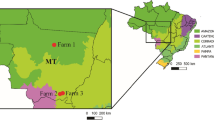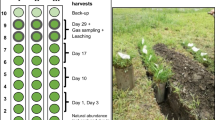Abstract
Four cultivars of groundnut were grown in upland soil in Northeast Thailand to study the residual benefit of the stover to a subsequent maize crop. An N-balance estimate of the total residual N in the maize supplied by the groundnut was made. In addition three independent estimates were made of the residual benefits to maize when the groundnut stover was returned to the land and incorporated. The first estimate (Estimate 1) was an N-balance estimate. A dual labelling approach was used where 15N-labelled stover was added to unlabelled microplots (Estimate 2) or unlabelled stover was added to 15N-labelled soil microplots (Estimate 3). The nodulating groundnut cultivars fixed between 59–64% of their nitrogen (as estimated by the 15N isotope dilution method using non-nodulating groundnut as a non-fixing reference) producing between 100 and 130 kg N ha-1 in their stover. Although the following maize crop suffered from drought stress, maize grain N and dry weights were up to 80% and 65% greater respectively in the plots where the stover was returned as compared with the plots where the stover was removed. These benefits were comparable with applications of 75 kg N ha-1 nitrogen in the form of urea. The total residual N estimates of the contribution of the nodulated groundnut to the maize ranged from 16.4–27.5 kg N ha-1. Estimates of the residual N supplied by the stover and fallen leaves ranged from 11.9–21.3 kg N ha-1 using the N-balance method (Estimate 1), from 6.3–9.6 kg N ha-1 with the labelled stover method (Estimate 2) and from 0–11.4 kg N ha-1 with the labelled soil method. There was closest agreement between the two 15N based estimates suggesting that ‘apparent added nitrogen interactions’ in these soils may not be important and that N balance estimates can overestimate the residual N in crops following legumes, even in very poor soils. This work also indicates the considerable ability of local groundnut cultivars to fix atmospheric nitrogen and the potential benefits from returning and incorporating legume residues to the soil in the upland cropping systems of Northeast Thailand. The applicability of the 15N methodology used here and possible reasons for the discrepancies between estimates 1, 2 and 3 are discussed.
Similar content being viewed by others
References
Azam F, Malik K A and Sajjad M I 1985 Transformations in soil and availability to plants of 15N applied as inorganic fertilizer and legume residues. Plant and Soil 86, 3–13.
Dakora F D, Aboyinga R A, Mahama Y and Apaseku J 1987 Assessment of N2-fixation in groundnut (Arachis hypogaea) and cowpea (Vigna unguiculata L. Walp) and their relative N contribution to a succeeding maize crop in Northern Ghana. MIRCEN J. 3, 389–399.
Fox R H, Myers R J K and Vallis I 1990 The nitrogen mineralization rate of legume residues in the soil as influenced by their polyphenol, lignin and nitrogen contents. Plant and Soil 129, 251–259.
Giller K E, McDonagh J F and Cadisch G 1993 Can biological nitrogen fixation sustain agricultural production in the tropics? In Soil Science and Sustainable Land Management. Eds. J K Syers and D L Rimmer. CAB International. Wallingford (In press).
Giller K E, Nambiar P T C, Srinivasa Rao B, Dart P J and Day J M 1987 A comparison of nitrogen fixation in genotypes of groundnut (Arachis hypogaea L.) using 15N-isotope dilution. Biol. Fert. Soils 5, 23–25.
Giller K E and Witty J F 1987 Slow release 15N fertilizer formulations increase the accuracy of field estimates of nitrogen fixation by isotope dilution. Soil Biol. Biochem. 19, 459–463.
Jenkinson D S, Fox R H and Rayner J H 1985 Interactions between fertilizer nitrogen and soil nitrogen — the so-called ‘priming effect’ J. Soil Sci. 36, 425–444.
Myers R J K and Wood I M 1986 The role of food legumes in the nitrogen cycle of farming systems. In Food Legume Improvement for Asian Farming Systems. Eds. E S Wallis and D E Byth. pp 46–52: Proceedings of an international workshop held at Khon Kaen Thailand, September, 1986. ACIAR Proceedings. No 18, Khon Kaen, Thailand.
Payne R W 1987 Genstat 5 Reference manual. Clarendon Press, Oxford. 749 p.
Sisworo W H, Mitrosuhardjo M M, Rasjid H and Myers R J K 1990 The relative roles of N fixation, fertilizer, crop residues and soil in supplying N in multiple cropping systems in a humid, tropical upland cropping system. Plant and Soil 121, 73–82.
Suwanarit A, Suwanarit C and Chotechaungmanirat S 1986 Quantities of fixed N and effects of grain legumes on following maize, and N and P status of soil as indicated by isotopes. Plant and Soil 93, 249–258.
Toomsan B 1990 Groundnut microbiology research at Khon Kaen University. In Groundnut Improvement Project Khon Kaen University. Ed. A Patanothai. pp 89–111. Report of Work for 1986–1988. Faculty of Agriculture, Khon Kaen University, Khon Kaen, Thailand.
Waring S A and Bremner J M 1964 Ammonium production in soil under waterlogged conditions as an index of nitrogen availability. Nature 201, 951–953.
Witty J F 1983 Estimating N2-fixation in the field using 15N-labelled fertilizer: some problems and solutions. Soil Biol. Biochem. 15, 631–639.
Author information
Authors and Affiliations
Rights and permissions
About this article
Cite this article
McDonagh, J.F., Toomsan, B., Limpinuntana, V. et al. Estimates of the residual nitrogen benefit of groundnut to maize in Northeast Thailand. Plant Soil 154, 267–277 (1993). https://doi.org/10.1007/BF00012532
Received:
Accepted:
Issue Date:
DOI: https://doi.org/10.1007/BF00012532




